와편모충류
"오늘의AI위키"의 AI를 통해 더욱 풍부하고 폭넓은 지식 경험을 누리세요.
1. 개요
와편모충류는 "소용돌이치는"을 의미하는 그리스어 "dinos"와 "채찍"을 의미하는 라틴어 "flagellum"의 합성어로, 단세포 진핵생물이다. 이들은 두 개의 편모를 사용하여 독특하게 헤엄치며, 암피에스마라는 복잡한 세포 덮개를 가지고 있다. 와편모충류는 광합성, 혼합 영양, 종속 영양 등 다양한 영양 전략을 보이며, 해양, 기수, 담수 등 다양한 환경에서 서식한다. 일부 종은 적조 현상을 일으키며, 생물 발광 능력을 가진 종도 존재한다. 와편모충류는 피하낭류, 섬모충류, 정단복합체충류와 함께 잘 지지되는 분기군을 형성하며, 디노카리온의 유무에 따라 분류된다. 화석 기록과 분자 계통 발생학 연구를 통해 와편모충류의 진화 역사가 밝혀졌으며, 다양한 공생 관계와 엽록체 획득 과정을 거쳐왔다.
더 읽어볼만한 페이지
- 와편모충류 - 야광충
야광충은 전 세계 해양에 널리 분포하며 생물 발광을 일으키는 단세포 편모 생물로, 적조 현상을 유발하거나 해양 먹이 사슬에서 중요한 역할을 한다. - 와편모충류 - 김노디니움목
김노디니움목은 김노디니움과, 카레니과, 워노비아과 등을 포함하는 다양한 과의 분류군이며, 일부 과는 악티니스쿠스목으로 분류되기도 하고 워노비아과의 일부 종은 안점을 특징으로 한다. - 편모충류 - 스토레아툴라속
스토레아툴라속은 세균에 속하는 속이다. - 편모충류 - 메타모나다
메타모나다는 흰개미 창자에 서식하며 목재 내 셀룰로스 분해에 중요한 역할을 하는 진핵생물군으로, 미토콘드리아가 없거나 변형된 수소소체 또는 마이토솜을 가지며, 엑스카바타에 속하는 것으로 분류된다. - 원생생물 - 유공충
유공충은 단단한 껍질을 가진 원생생물로, 껍질 형태와 구성에 따라 분류되며, 해양 환경에서 생물 층서 및 고기후 연구, 석유 탐사 등 다양한 분야에 활용된다. - 원생생물 - 코아노조아
코아노조아는 칼라 구조를 특징으로 하는 깃편모충류와 동물을 포함하는 계통 분류군으로, 동물의 기원과 밀접한 관련이 있으며, 동물 진화 연구에 중요한 연결고리를 제공한다.
2. 어원
"와편모충류"라는 용어는 그리스어 'dinos'와 라틴어 'flagellum'의 합성어이다. 'Dinos'는 "회전하는"을 의미하며, 와편모충류가 헤엄치는 독특한 방식을 나타낸다. 'Flagellum'은 "채찍"을 의미하며, 이는 와편모충류의 편모를 가리킨다.[13]
1753년, 헨리 베이커는 최초의 근대 와편모충류를 "해수에서 빛을 내는 작은 동물"로 묘사했으며,[14] 1773년 오토 프리드리히 뮐러에 의해 명명되었다.[15] '와편모충류'라는 용어는 회전을 의미하는 그리스어 δῖνος (''dînos'')와 채찍 또는 벌을 뜻하는 라틴어 ''flagellum''에서 유래되었다.
와편모충류는 단세포 생물이며, 복부 세포 쪽에서 나오는 두 개의 서로 다른 편모를 가지고 있다. 가로 편모는 리본 모양으로 세포의 왼쪽에서 물결치며 움직이고, 세로 편모는 뒤쪽으로 움직인다.[18][19][20] 가로 편모는 바깥쪽 가장자리만 밑부분에서 끝부분으로 흔들리며, 축삭의 가장자리에는 다양한 길이의 단순한 털이 있다. 편모 운동은 전방 추진력과 회전력을 생성한다. 세로 편모는 비교적 일반적이며 털이 거의 없거나 아예 없다. 그것은 파동에 한두 번만 주기적으로 움직인다. 데스모콘트 편모를 가진 와편모충류 종(예: ''Prorocentrum'')에서는 두 편모가 디노콘트와 같이 분화되지만, 홈과는 관련이 없다.
3. 역사
1830년대, 독일의 현미경학자 크리스티안 고트프리트 에렌베르크는 많은 물과 플랑크톤 샘플을 조사하여 오늘날에도 사용되는 여러 와편모충류 속, 즉 ''페리디늄(''Peridinium''), ''프로로센트럼(''Prorocentrum''), ''다이노피시스(''Dinophysis'')''를 제안했다.[16]
1885년 오토 뷰칠리는 이 와편모충류를 편모충강 Dinoflagellida로 처음 정의했다.[17] 식물학자들은 이들을 조류의 한 문으로 취급하여 생물 발광 형태를 따서 '''Pyrrophyta''' 또는 '''Pyrrhophyta'''("불 조류"; 그리스어 ''pyrr(h)os'', 불) 또는 '''Dinophyta'''라고 명명했다. 다양한 시기에 은편모조류, 에브리드류, 엘로비옵시드류가 여기에 포함되었지만, 현재는 마지막 종류만이 근연종으로 간주된다. 와편모충류는 비낭에서 낭 형성 전략으로 변형될 수 있는 능력이 있는 것으로 알려져 있어, 진화 역사를 재구성하기가 매우 어렵다.
4. 형태
와편모충류는 '''암피에스마'''(amphiesma)라고 불리는 복잡한 세포 덮개를 가지고 있으며, 이는 일련의 막, 소포 및 관련 구조로 구성되어 있다.[21][22] 각판(thecate) 와편모충류는 겹치는 셀룰로스 판을 지지하여 '''각판'''(theca) 또는 로리카(lorica)라고 불리는 일종의 갑옷을 형성한다. 이들은 종에 따라 다양한 모양과 배열로 나타나며, 때로는 와편모충류의 단계에서 나타나기도 한다. 이러한 각판들의 배열을 지칭하기 위해 판 배열이라는 용어가 사용되어 왔다. 판 구성은 판 공식 또는 판 배열 공식으로 표시할 수 있다. 섬유성 압출물은 또한 많은 형태에서 발견된다.[25][24]
이러한 조직은 와편모충류, 톡소포자충, 섬모충 사이의 밀접한 관계를 나타내며, 이들을 통칭하여 폐포생물이라고 한다.[25]
4. 1. 띠와 홈
와편모충류 세포는 가로 홈인 띠(cingulum)와 세로 홈인 홈(sulcus)으로 나뉜다. 띠는 세포를 둘러싸고 있으며, 앞쪽(에피소마)과 뒤쪽(하이포소마)으로 나뉜다. 각판이 있는 경우에만 해당 부분을 각각 표각과 하각이라고 한다. 홈은 띠에서 시작하여 뒤쪽으로 뻗어 있다. 가로 편모는 띠에서, 세로 편모는 홈에서 움직인다.[23][24]
5. 생태 및 생리
와편모충류는 해양, 기수, 담수 등 모든 수생 환경에서 발견되며, 눈이나 얼음 속에서도 발견된다.[34] 저서 환경과 해빙에서도 흔히 볼 수 있다.[34] 와편모충류 종의 약 절반은 엽록체를 가진 자가영양생물이고, 나머지 절반은 광합성을 하지 않는 종속영양생물이다.[34]
페리디닌 와편모충류는 페리디닌 색소체에서 이름을 따왔으며, 와편모충류 계통의 조상으로 보인다. 알려진 종의 거의 절반이 엽록체를 가지고 있는데, 이는 원래의 페리디닌 색소체이거나 세포내 공생을 통해 다른 단세포 조류 계통에서 얻은 새로운 색소체이다. 나머지 종들은 광합성 능력을 상실하고 종속영양, 기생 또는 엽록체포식 생활 방식에 적응했다.[34][35]
진핵생물로 분류되지만, 와편모충류의 핵은 전형적인 진핵생물은 아니다. 일부는 히스톤과 뉴클레오솜이 없고, 분열 동안 계속 응축된 염색체를 유지한다. 와편모충류 핵은 Dodge (1966)에 의해 '중핵형'이라고 명명되었는데,[36] 이는 원핵세균의 코일 DNA 영역과 잘 정의된 진핵생물 핵 사이의 중간 특성을 가지고 있기 때문이다. 그러나 이 그룹에는 골지체, 미토콘드리아 및 엽록체와 같은 전형적인 진핵생물 세포 소기관이 포함되어 있다.[37]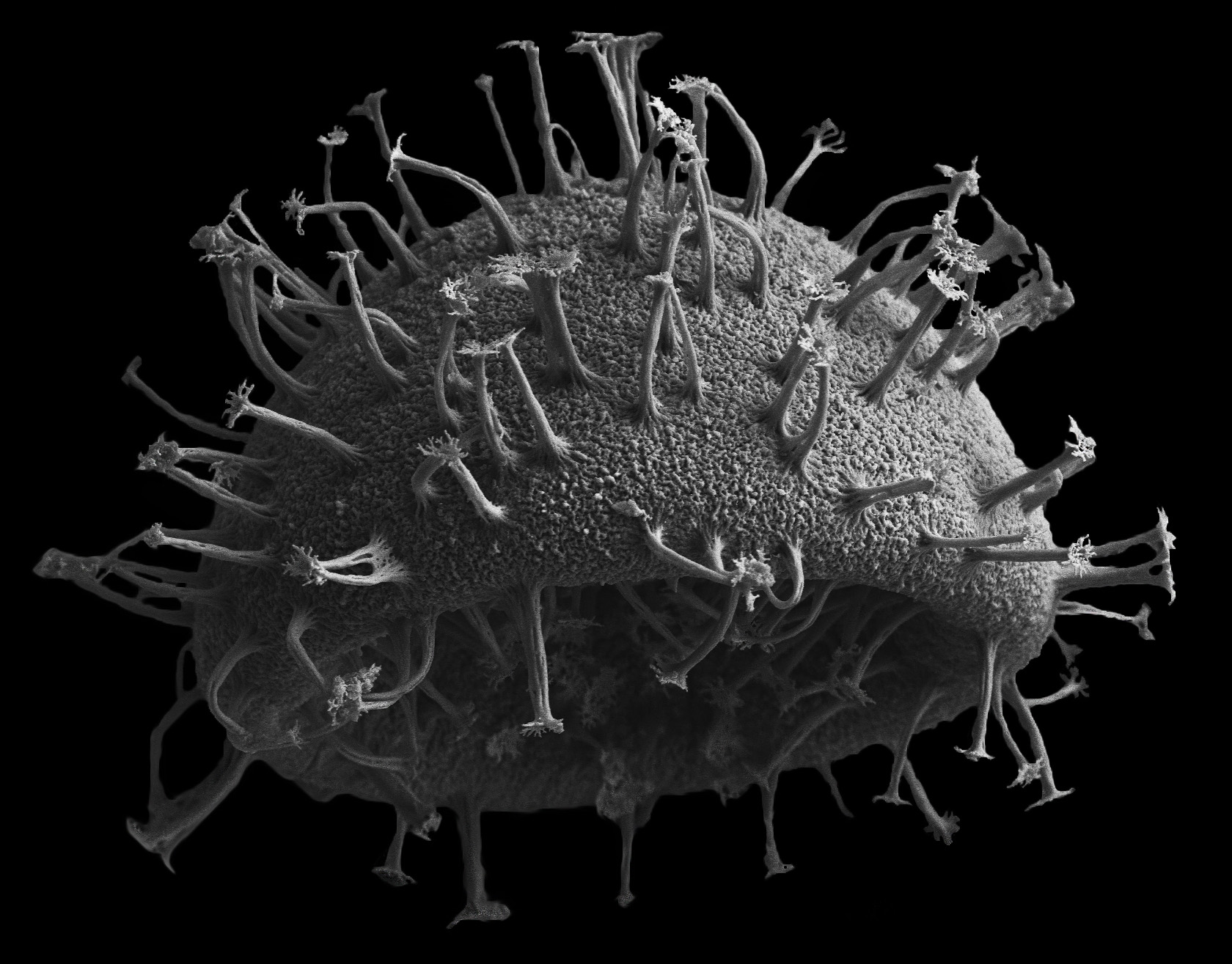
5. 1. 영양 전략
와편모충류는 광합성, 혼합 영양, 종속 영양의 세 가지 주요 영양 전략을 보인다.[54] 광합성 와편모충류는 광합성 독립 영양 생물 또는 영양 요구성 생물일 수 있다. 혼합영양 와편모충류는 광합성과 종속영양을 모두 수행한다.[54] 일부 와편모충류는 다른 생물을 포식하거나 기생하며,[54] 먹이 포획 및 섭취 메커니즘은 매우 다양하다.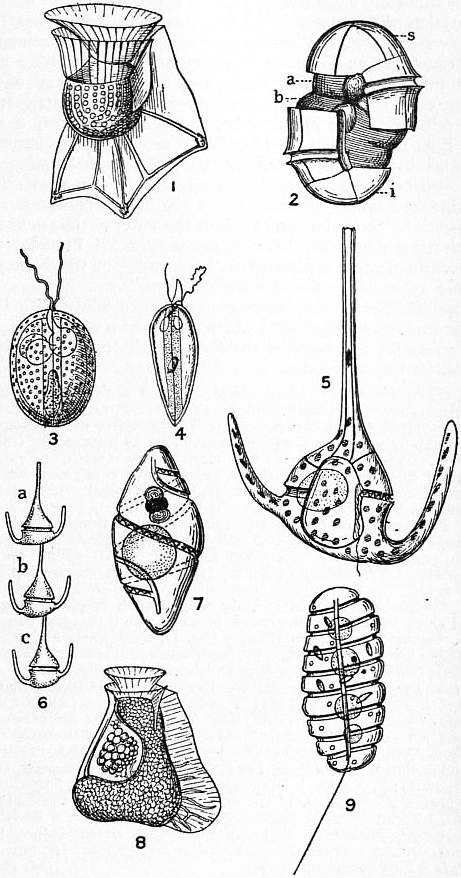
- 포식: 일부 와편모충류는 박테리아, 남조류, 작은 편모조류, 규조류, 섬모류 및 기타 편모조류 등을 먹이로 삼는다.[54]
- ''Ceratium hirundinella''[60], ''Peridinium globulus''[58]와 같은 유각 와편모충류와 ''Oxyrrhis marina''[56], ''Gymnodinium'' sp.[62], ''Kofoidinium'' spp.[63]와 같은 무각 와편모충류는 먹이를 세포의 sulcal 영역으로 끌어들여 섭취한다.
- ''Protoperidinium'' spp. (예: ''P. conicum'')는 큰 먹이 베일(pallium)을 돌출시켜 먹이를 포획하고 세포 외 소화를 통해 소화한다.[64][65]
- ''Katodinium (Gymnodinium) fungiforme''은 먹이에 부착하여 신장성 peduncle을 통해 먹이의 세포질을 섭취한다.[68]
- ''Polykrikos kofoidii''와 ''Neatodinium''은 작살 모양의 소기관을 쏘아 먹이를 포획한다.[69]
- 엽록체포식: 일부 와편모충류는 먹이에서 얻은 외래 엽록체(cleptochloroplasts)를 일시적으로 사용하여 광합성을 한다.[54]
- 혼합영양과 독소: 일부 혼합영양 와편모충류는 신경독소를 생성하여 먹이 생물을 마비시키거나 포식자를 억제한다.
- ''K. veneficum''은 칼로톡신을 생성하여 포식자를 죽이고, 더 큰 먹이를 고정시켜 포식 능력을 향상시킨다.[70]
- ''K. arminger''는 접촉 시 먹이를 고정시키는 신경독소를 방출하여 요각류를 먹이로 삼는다.[71]
5. 2. 공생
주산텔라는 모두 와편모충류이며, 대부분은 심비오디니움과(Symbiodiniaceae) (예: 심비오디니움 속)에 속한다.[52] 심비오디니움과 산호초를 만드는 산호 사이의 연관성은 널리 알려져 있다. 그러나 공생 주산텔라는 말미잘, 해파리, 갯민숭달팽이, 대왕조개 ''Tridacna'', 방산충과 유공충 등 많은 무척추동물과 원생생물에도 서식한다.[53] 많은 현존하는 와편모충류는 기생충(내부에서 먹이를 먹는 내부 기생충, 또는 더 오랜 기간 동안 먹이에 부착되어 있는 외부 기생충)이다. 이들은 동물 또는 원생생물 숙주에 기생할 수 있다. ''Protoodinium, Crepidoodinium, Piscinoodinium'' 및 ''Blastodinium''은 동물플랑크톤 또는 어류 숙주를 먹는 동안 엽록체를 유지한다. 대부분의 기생 와편모충류에서 감염 단계는 전형적인 운동성 와편모충류 세포와 유사하다.5. 3. 유해 조류 대번식 (적조)
와편모조류는 때때로 1ml당 백만 개 이상의 세포 농도로 대번식을 일으키기도 한다. 이러한 상황에서 와편모조류는 물고기를 죽이거나 조개류와 같은 여과 섭식자에게 축적될 수 있는 독소(와편모조류 독소)를 생성하며, 이는 다시 그것을 먹는 사람에게 전달될 수 있다.[75] 이러한 현상을 조류 대번식이 물에 부여하는 색상에서 유래하여 적조라고 한다. 무색 와편모조류 중 일부는 ''Pfiesteria''와 같이 독성 대번식을 형성할 수도 있다.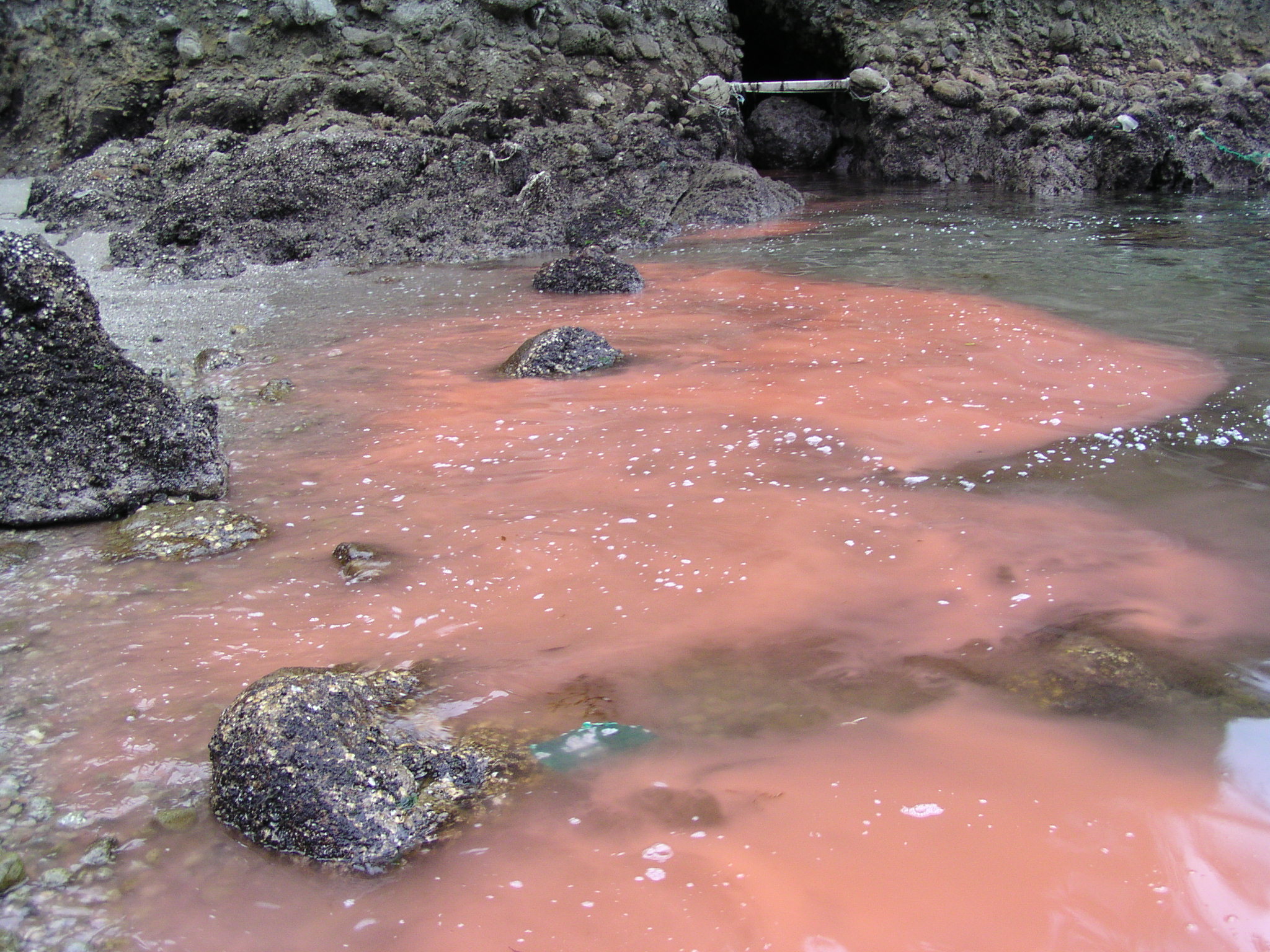
적조는 와편모조류가 물속에 풍부한 영양소의 결과로 빠르게 대량으로 번식할 수 있기 때문에 발생한다. 그 결과로 나타나는 붉은 물결은 흥미로운 시각적 현상이지만, 해양 생물뿐만 아니라 그것을 섭취하는 사람들에게도 영향을 미치는 독소를 포함하고 있다.[75] 특정 매개체는 조개류이다. 이는 치명적이지 않은 질병과 치명적인 질병을 모두 유발할 수 있다. 그러한 독소 중 하나는 강력한 마비성 신경독인 삭시톡신이다.[76][77][78] 인간의 인산염 투입은 이러한 적조를 더욱 조장하므로 의학적, 경제적 관점에서 와편모조류에 대해 더 많은 것을 배우는 데 큰 관심이 있다. 와편모조류는 용존 유기 인을 P-영양소로 청소하는 데 특히 능숙한 것으로 알려져 있으며, 여러 유해 조류 대번식(HAS) 종은 다양한 유형의 DOP를 활용하는 데 있어 매우 다재다능하고 기계적으로 다양하다는 것이 밝혀졌다.[76][77] 유해 조류 대번식의 생태학이 광범위하게 연구되고 있다.[79]
5. 4. 생물 발광
밤에는 와편모충류의 생물 발광 현상으로 인해 물이 반짝이는 빛을 띨 수 있다.[80][81] 18개 이상의 와편모충류 속이 생물 발광을 하며,[82] 이들 대부분은 청록색 빛을 낸다.[83] 이 종들은 신틸론을 함유하고 있는데, 이는 세포의 피질 부위에 주로 분포하는 개별적인 세포질 덩어리(지름 약 0.5um)로, 주 세포 액포의 돌출부이다. 신틸론은 와편모충류 생물 발광에 관여하는 주요 효소인 와편모충 루시페라제와 빛을 생성하는 반응의 기질 역할을 하는 엽록소 유도 테트라피롤 고리인 루시페린을 함유하고 있다. 생물 발광은 자극을 받으면 짧은(0.1초) 파란색 섬광(최대 476nm)으로 나타나며, 이는 보통 기계적인 교란에 의해 발생한다. 따라서 배, 수영 또는 파도와 같은 기계적 자극을 받으면 바다 표면에서 파란색의 반짝이는 빛이 방출되는 것을 볼 수 있다.[84]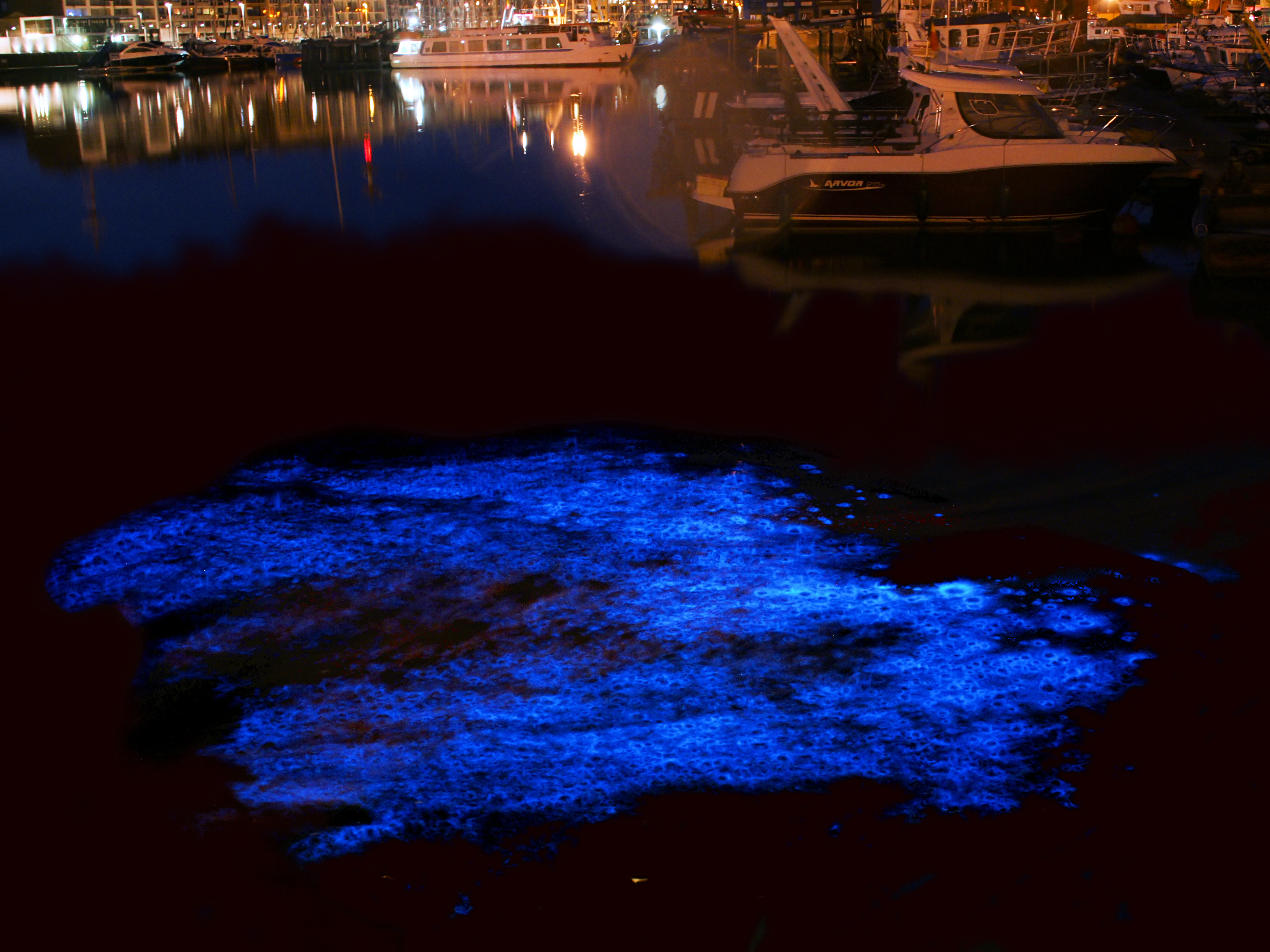

와편모충류 생물 발광은 일주기 시계에 의해 제어되며 밤에만 발생한다.[85] 발광하는 균주와 발광하지 않는 균주는 동일한 종에서 발생할 수 있다. 신틸론의 수는 밤에 더 많으며, 최대 생물 발광 시간인 밤의 끝에 분해된다.[86]
생물 발광을 담당하는 루시페린-루시페라제 반응은 pH에 민감하다.[84] pH가 떨어지면 루시페라제가 모양을 바꾸어 루시페린, 더 구체적으로는 테트라피롤이 결합할 수 있게 한다.[84] 와편모충류는 생물 발광을 방어 기작으로 사용할 수 있다. 섬광으로 포식자를 놀라게 하거나, "도둑 경보"와 같은 간접적인 효과로 잠재적 포식자를 물리칠 수 있다. 생물 발광은 와편모충류와 공격자에 대한 주의를 끌어, 포식자가 더 높은 영양 단계로부터의 포식에 취약하게 만든다.[84]
생물 발광 와편모충류 생태계 만은 가장 희귀하고 취약한 생태계 중 하나이며,[87] 가장 유명한 곳으로는 푸에르토리코 라하스의 생물 발광 만(La Parguera, Lajas), 푸에르토리코 비에케스의 모스키토 만, 그리고 라스 카베자스 데 산 후안 자연 보호 구역(푸에르토리코 파하르도)이 있다. 또한, 자메이카 몬테고 베이 근처에도 생물 발광 석호가 있으며, 메인 주 캐스틴 주변에도 생물 발광 항구가 있다.[88] 미국 내에서는 인디언 리버 석호가 여름에는 와편모충류, 겨울에는 생물 발광 유즐동물을 풍부하게 품고 있다.[89]
6. 생활사
와편모충류는 야광충과 그 관련 종들을 제외하고는 단상 생활사를 가진다.[5] 생활사는 보통 desmoschisis나 eleuteroschisis를 통한 유사분열에 의한 무성 생식을 포함한다. 더욱 복잡한 생활사는 특히 기생성 와편모충류에서 발생한다. 유성 생식 또한 일어나는데,[92] 이러한 생식 방식은 소수의 와편모충류에서만 알려져 있다.[93] 이는 두 개체가 융합하여 접합자를 형성함으로써 이루어지며, 이 접합자는 전형적인 와편모충류 방식으로 이동할 수 있으며, 이를 플라노접합자(planozygote)라고 부른다. 이 접합자는 나중에 휴지기 또는 hypnozygote를 형성할 수 있으며, 이를 와편모충 시스트 또는 dinocyst라고 한다. 시스트의 발아 후(또는 전에) 부화한 유생은 새로운 단상 세포를 생성하기 위해 감수 분열을 거친다. 와편모충류는 다양한 유형의 DNA 손상을 처리할 수 있는 여러 가지 DNA 복구 과정을 수행할 수 있는 것으로 보인다.[94]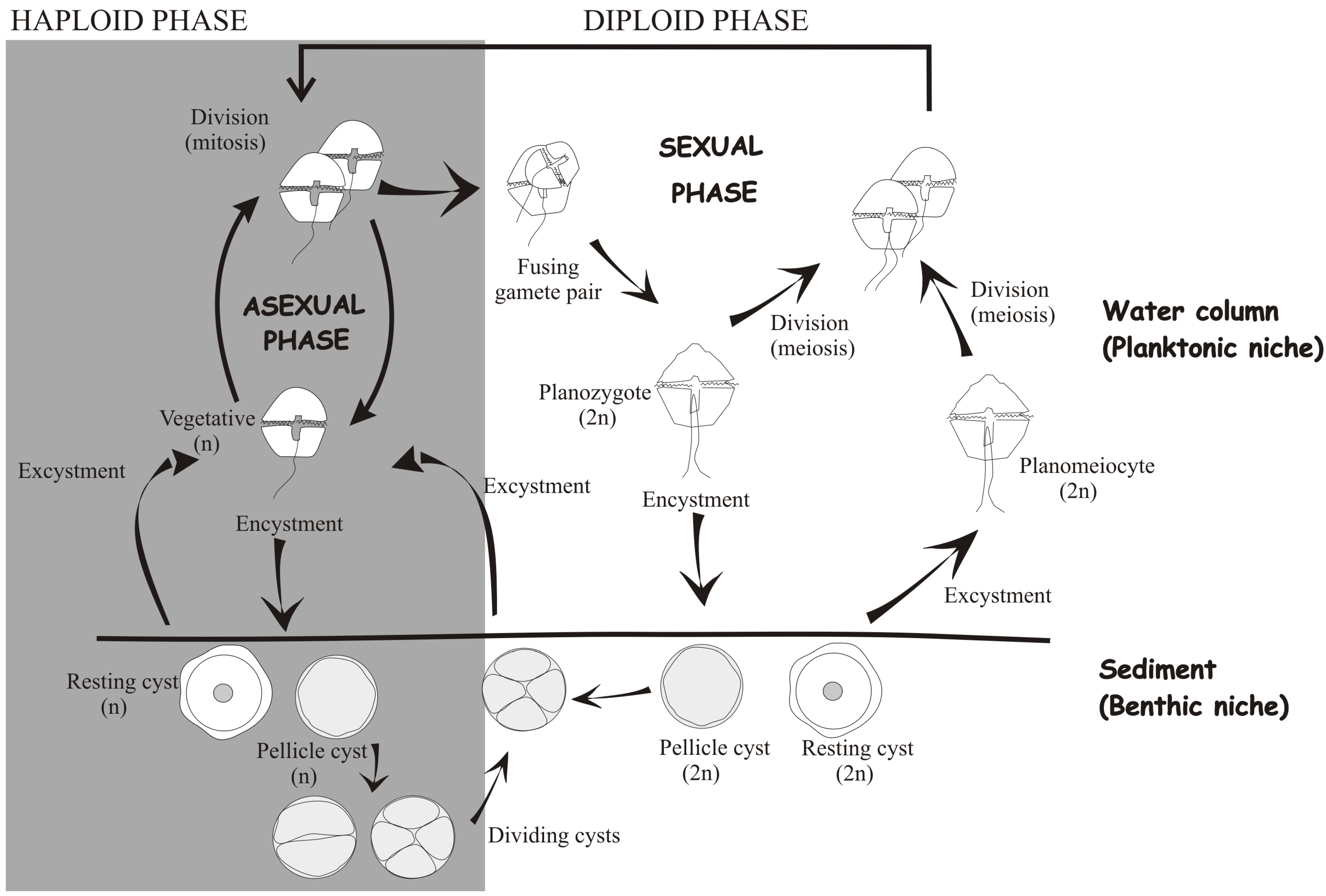
많은 와편모조류의 생활사에는 적어도 하나의 비편모 생태 단계인 시스트가 포함된다. 다양한 유형의 와편모조류 시스트는 주로 형태학적(세포벽의 층 수와 유형) 및 기능적(장기 또는 단기 내구력) 차이에 따라 정의된다. 이러한 특징은 처음에 피막 (얇은 벽) 시스트와 휴면 (이중 벽) 와편모조류 시스트를 명확하게 구분하는 것으로 여겨졌다. 전자는 단기적(일시적) 시스트, 후자는 장기적(휴면) 시스트로 간주되었다. 그러나 지난 20년 동안 추가적인 지식으로 와편모조류 생활사의 엄청난 복잡성이 강조되었다.[95]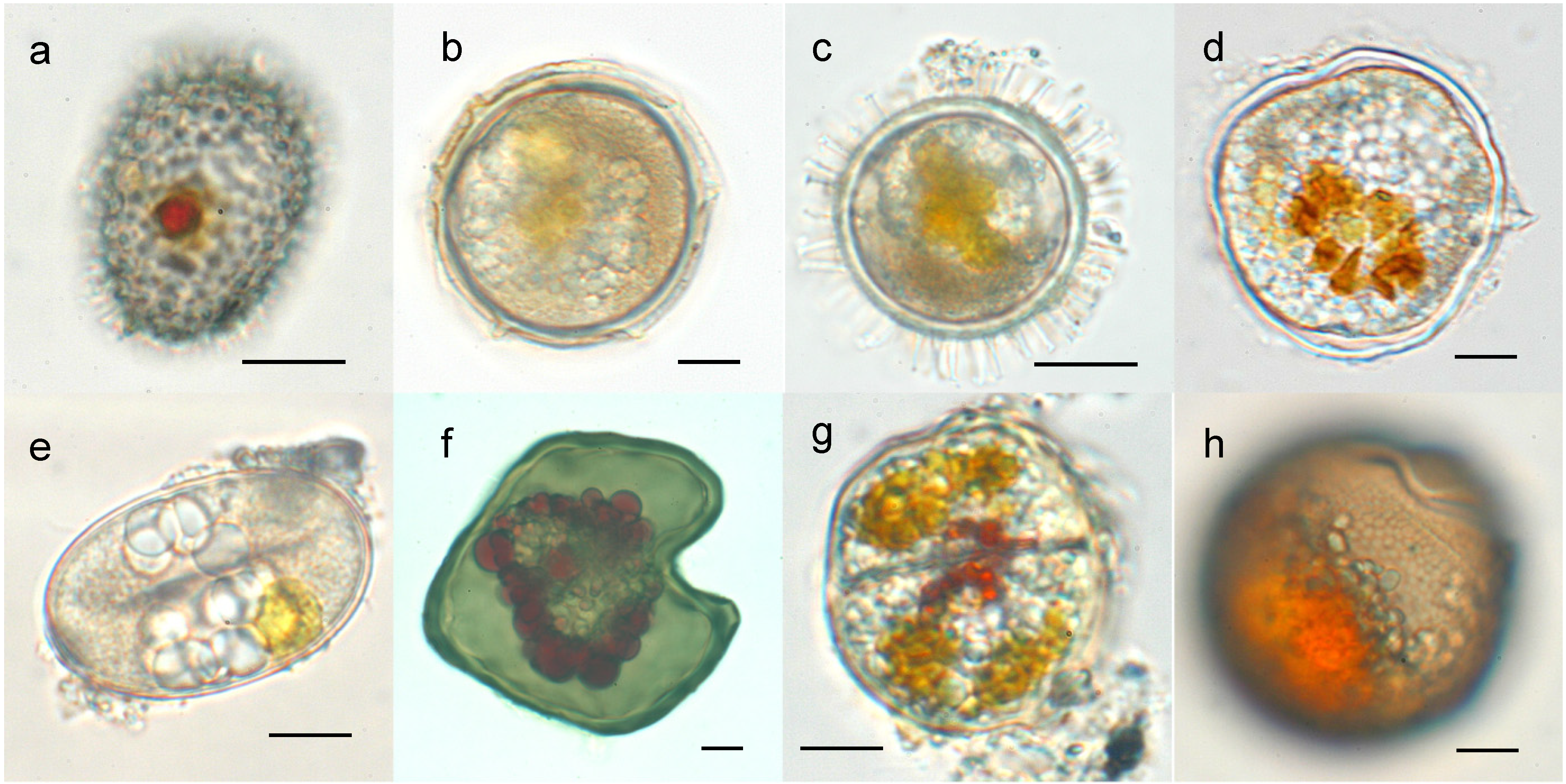
약 2,000종으로 알려진 해양 와편모조류의 10% 이상이 생활사의 일부로 시스트를 생성한다(오른쪽 그림 참조). 이러한 저서 단계는 종의 생태에 중요한 역할을 하는데, 이는 시스트가 식물성 성장에 불리한 조건에서 퇴적층에 남아 있다가 유리한 조건이 회복되면 물기둥으로 다시 재접종되는 플랑크톤-저서 연결의 일부로서 기능한다.[95]
실제로 와편모조류 진화 과정에서 변동하는 환경 및/또는 계절성에 적응해야 할 필요성이 이러한 생활사 단계를 발전시킨 것으로 생각된다. 대부분의 원생생물은 기아와 자외선 손상을 견디기 위해 휴면 시스트를 형성한다.[96]
7. 계통 분류
피하낭류에 속하는 와편모충류는 섬모충류, 정단복합체충류와 함께 잘 지지되는 분기군을 형성한다. 와편모충류는 크게 디노카리온(dinokaryon)을 가진 그룹과 가지지 않은 그룹(신디니움강)으로 나뉜다.[160][161][162]
다음은 피하낭류의 계통 분류이다.[160][161][162]
7. 1. 하위 분류
와편모충류는 다음과 같은 목(order)으로 분류된다.[159]
8. 진화
와편모충류는 주로 디노시스트 화석으로 대표되며, 이는 중기 트라이아스기에 가장 낮은 출현 빈도를 보인다.[126] 지구화학적 지표는 초기 캄브리아기까지 와편모충류가 존재했음을 시사한다.[127] 일부 증거에 따르면 많은 고생대 및 선캄브리아기 암석에서 발견되는 디노스테로이드가 조상 와편모충류(원시 와편모충류)의 산물일 수 있다.[128][129] 와편모충류는 후기 트라이아스기에서 중기 쥐라기 동안 고전적인 형태의 방사형 분화를 보였으며,[132][130][131] 더욱 현대적인 형태는 후기 쥐라기와 백악기 동안 번성하였다.[132] 이러한 추세는 신생대까지 이어지며, 다양성이 다소 감소했다.[132][126]
분자 계통 발생학은 와편모충류가 섬모충 및 아피콤플렉스충(=포자충)과 함께 잘 지지되는 분기군인 알베올라타에 속한다는 것을 보여준다. 디노핵 와편모충류와 가장 가까운 친척은 아피콤플렉스충, ''Perkinsus, Parvilucifera'', 신디니안, 그리고 ''Oxyrrhis''로 보인다.[133] 분자 계통 발생학은 형태학에 기반한 계통 발생학과 유사하다.[134][135]
와편모충류 진화의 초기 단계는 기생 계통, 예를 들어 퍼킨시드 및 신디니안(예: ''Amoebophrya'' 및 ''Hematodinium'')이 지배하는 것으로 보인다.[136][137][138][139]
모든 와편모충류는 홍조류 엽록체 또는 홍조류 기원의 잔존(비광합성) 소기관을 포함한다.[140] 그러나 기생 와편모충류인 ''Hematodinium''은 엽록체가 전혀 없다.[141] 원래 홍조류 엽록체의 광합성 특성을 잃은 일부 그룹은 2차 및 3차 직렬 공생을 통해 새로운 광합성 엽록체(엽록체)를 획득했다.
- ''Lepidodinium''은 특이하게 녹조류 유래 엽록체를 가지고 있다(다른 모든 직렬 획득 엽록체는 홍조류로 거슬러 올라갈 수 있다).[142]
- ''Karenia'', ''Karlodinium'' 및 ''Takayama''는 세 번의 개별적인 사건으로 생성된 갈조류 기원의 엽록체를 가지고 있다.[144]
- "디노톰"(''Durinskia'' 및 ''Kryptoperidinium'')은 규조류에서 유래된 엽록체를 가지고 있다.[145][146]
- 일부 종은 흡수공생을 수행하기도 한다. ''Dinophysis''는 섬모충 포식으로부터의 흡수공생으로 인해 크립토모나드에서 유래된 엽록체를 가지고 있다.[147]
와편모충류의 진화는 5가지 주요 조직 유형, 즉 프로로센트로이드, 디노피소이드, 고니아울락소이드, 페리디니오이드 및 김노디니오이드로 요약되었다.[149] 와편모충류의 다양화 동안 해양 종이 담수로 전환되는 사건은 빈번하게 발생했으며 최근에 발생했다.[150]
많은 와편모충류는 시아노박테리아와의 공생 관계를 가지고 있는데, 이를 시아노비온트라고 부르며, 이들은 축소된 게놈을 가지고 있으며 숙주 밖에서는 발견되지 않았다. 와편모충류 ''Ornithocercus magnificus''는 세포 외 챔버에 서식하는 공생체를 위한 숙주인데, 와편모충류가 이것으로부터 어떻게 이점을 얻는지 완전히 알려져 있지 않지만, 특수 챔버에서 시아노박테리아를 키우고 정기적으로 일부를 소화하는 것으로 추정된다.[152]
최근, 살아있는 화석인 ''Dapsilidinium pastielsii''가 인도-태평양 열대 해역에 서식하는 것이 발견되었는데, 이는 열대성 와편모충류의 생존 지역 역할을 했다.[153]
참조
[1]
간행물
Estimating the timing of early eukaryotic diversification with multigene molecular clocks
2011-08
[2]
간행물
A checklist and classification of living dinoflagellates (Dinoflagellata, Alveolata)
[3]
간행물
A higher level classification of all living organisms
2015
[4]
서적
HAL Archives-ouvertes
https://hal.archives[...]
Creative Commons
2016-09-04
[5]
서적
A classification of living and fossil dinoflagellates
Sheridan Press
[6]
간행물
Mixotrophy among Dinoflagellates
[7]
서적
Progress in Botany: Genetics Physiology Systematics Ecology
https://books.google[...]
Springer
2020-10-22
[8]
간행물
How many species of algae are there?
2012-10
[9]
간행물
A review of recent freshwater dinoflagellate cysts: Taxonomy, phylogeny, ecology and palaeocology
[10]
간행물
Towards an Ecological Understanding of Dinoflagellate Cyst Functions
2014-01
[11]
간행물
A list of free-living dinoflagellate species in the world's oceans
https://hrcak.srce.h[...]
[12]
간행물
Dinoflagellate diversity and distribution
2008-02
[13]
서적
Freshwater Algae of North America
Academic Press
2015
[14]
서적
Employment for the microscope
http://catalog.hathi[...]
Dodsley
1753
[15]
문서
Vermium terrestrium et fluviatilium, seu Animalium Infusoriorum, Helmithicorum et Testaceorum, non marinorum, succincta historia, vol. 1. Pars prima.
Faber, Havniae, et Lipsiae
1773
[16]
문서
Beiträge zur Kenntnis der Organisation der Infusorien und ihrer geographischer Verbreitung, besonders in Sibirien. — Abhandlungen der Königlichen Akademie der Wissenschaften zu Berlin. Aus dem Jahre 1830. Physikalische Abhandlungen 1830
1832
[17]
문서
3. Unterabtheilung (Ordnung) Dinoflagellata. – In: Dr. H.G. Bronn's Klassen und Ordnungen des Thier-Reichs, wissenschaftlich dargestellt in Wort und Bild. Erster Band Protozoa
C.F. Winter'sche Verlagshandlung, Leipzig und Heidelberg
1885
[18]
간행물
Non-helical transverse flagella in dinoflagellates
1975-03
[19]
간행물
The propulsive mechanism of the dinoflagellate transverse flagellum reconsidered
1976-04
[20]
간행물
Form and function of the dinoflagellate transverse flagellum
1985-05
[21]
서적
Ultrastructure of the Dinoflagellate Amphiesma
[22]
서적
Ch. 3: Dinoflagellate cell cortex
https://books.google[...]
Academic Press
2016-03-05
[23]
간행물
"Symbiodinium microadriaticum'' Freudenthal, ''S. goreauii'' sp. nov., ''S. kawagutii'' sp. nov. And ''S. pilosum'' sp. nov.: Gymnodinioid Dinoflagellate Symbionts of Marine Invertebrates"
[24]
간행물
"Symbiodinium'' gen. Nov. And ''Symbiodinium microadriaticum'' sp. nov., a Zooxanthella: Taxonomy, Life Cycle, and Morphology"
[25]
서적
The biology of free-living heterotrophic flagellates
Clarendon Press
[26]
서적
Biological and Geological Perspectives of Dinoflagellates
Geological Society of London
2013
[27]
간행물
The endosymbiotic origin, diversification and fate of plastids
2010-03
[28]
간행물
Dinoflagellates: a remarkable evolutionary experiment
2004-10
[29]
간행물
You are what you eat
2004-09
[30]
서적
The Paleobiology of Plant Protists
W.H. Freeman
[31]
간행물
Loss of nucleosomal DNA condensation coincides with appearance of a novel nuclear protein in dinoflagellates
2012-12
[32]
서적
Dinoflagellate nuclei
https://books.google[...]
Academic Press
2016-03-05
[33]
간행물
Single cell genomics of uncultured marine alveolates shows paraphyly of basal dinoflagellates
http://discovery.ucl[...]
2018-10-23
[34]
간행물
Genome evolution of a tertiary dinoflagellate plastid
2011-04
[35]
간행물
Did the peridinin plastid evolve through tertiary endosymbiosis? A hypothesis
[36]
서적
Identifying Marine Phytoplankton
Academic Press
2016-03-05
[37]
서적
Identifying Marine Phytoplankton
Academic Press
2016-03-05
[38]
간행물
Dinoflagellatae (Peridinineae) in monographischer Behandlung. In: RABENHORST, L. (ed.), Kryptogamen-Flora von Deutschland, Österreichs und der Schweiz. Akad. Verlag., Leipzig. Vol. 10 (3): Teil 1 (1–3) (1931–1933): Teil 2 (1–4)(1935–1937).
1931–1937
[39]
논문
Catalogue des espèces et taxons infraspécifiques de dinoflagellés marins actuels publiés depuis la révision de J. Schiller. I. Dinoflagellés libres
[40]
논문
Catalogue des espèces et taxons infraspécifiques de dinoflagellésmarins actuels publiés depuis la révision de J. Schiller. III (Complément)
https://www.biodiver[...]
[41]
논문
Catalogue des espèces et taxons infraspécifiques de dinoflagellésmarins actuels publiés depuis la révision de J. Schiller. IV. (Complément)
[42]
논문
Catalogue des espèces et taxons infraspécifiques de dinoflagellésmarins actuels publiés depuis la révision de J. Schiller. V. (Complément)
[43]
논문
Catalogue des espèces et taxons infraspécifiques de dinoflagellésmarins actuels publiés depuis la révision de J. Schiller. VI. (Complément)
https://www.biodiver[...]
[44]
간행물
Atlas du Phytoplancton Marin. Vol. I: Introduction, Cyanophycées,Dictyochophycées, Dinophycées et Raphidophycées.
Editions du CNRS, Paris.
[45]
서적
Dinoflagellates
Marine Research Laboratory
[46]
서적
Dinoflagellates from the International Indian Ocean Expedition: A Report on Material Collected by the R.V. "Anton Bruun" 1963–1964
E. Schweizerbart
[47]
서적
Marine Dinoflagellates of the British Isles
http://catalog.hathi[...]
Her Majesty's Stationery Office
1982
[48]
논문
Checklist of Mediterranean free-living dinoflagellates
2003-04
[49]
서적
Marine phytoplankton: selected microphytoplankton species from the North Sea around Helgoland and Sylt
E. Schweizerbart'sche Verlagsbuchhandlung (Nägele und Obermiller)
[50]
서적
Dinophyceae (Dinoflagellida)
https://books.google[...]
Fischer
[51]
논문
A rapid simple technique utilizing calcofluor white M2R for the visualization of dinoflagellate thecal plates
1985-12
[52]
문서
Freudenthal et al. 2007
[53]
서적
Proceedings of the eighth International Coral Reef Symposium, Panama, June 24–29, 1996
Smithsonian Tropical Research Institute
[54]
논문
Nutritional strategies in dinoflagellates: A review with emphasis on cell biological aspects
1992-02
[55]
논문
The free-living unarmoured dinoflagellata
https://www.biodiver[...]
2019-09-24
[56]
논문
The culture and physiology of the marine dinoflagellates
[57]
논문
Recherches sur les Peridiniens
[58]
논문
The annual oceanographic cycle at Igloolik in the Canadian Arctic. II. The phytoplankton
[59]
논문
Possible phagotrophic feeding in ''Ceratium lunula'' Schimper
[60]
논문
The morphology and fine structure of ''Ceratium hirundinella'' (Dinophyceae)
1970-06
[61]
논문
On the taxonomy of unarmored dinophytes (Dinophyta) from the Northwest African upwelling region
[62]
논문
Dinoflagellate phagotrophy in the upper Great Lakes
[63]
논문
Le systeme stomatopharyngien de Kofoidinium Pavillard. Comparisons avec celui divers Peridiniens fibres et parasites
[64]
논문
Extracellular digestion in marine dinoflagellates
[65]
논문
Thecate heterotrophic dinoflagellates: feeding behavior and mechanisms
1986-09
[66]
논문
Feeding, growth, and behavior of the thecate heterotrophic dinoflagellate ''Oblea rotunda''
[67]
논문
Growth and grazing by the thecate heterotrophic dinoflagellates ''Diplopsalis lenticula'' (Diplopsalidaceae, Dinophyceae)
1998-01
[68]
논문
Phagotrophy in ''Gymnodinium fungiforme'' (Pyrrophyta): the peduncle as an organelle of ingestion
1982-09
[69]
웹사이트
Researchers capture dinoflagellate on video shooting harpoons at prey
https://phys.org/new[...]
2019-05-19
[70]
논문
Karlotoxin mediates grazing by ''Oxyrrhis marina'' on strains of ''Karlodinium veneficum''
2007
[71]
논문
Marine microalgae attack and feed on metazoans
2012-10
[72]
서적
Die Peridineen der Plankton-Expedition
Allgemeiner Theil
[73]
논문
Adaptive ecology, growth strategies and the global bloom expansion of dinoflagellates
[74]
논문
Chemically-mediated rejection of dinoflagellate prey by the copepods ''Calanus pacificus'' and ''Paracalanus parvus'': mechanism, occurrence and significance
[75]
서적
Identifying Harmful Marine Dinoflagellates
http://www.nmnh.si.e[...]
Department of Systematic Biology, Botany, National Museum of Natural History
2007-05-18
[76]
논문
Phosphorus physiological ecology and molecular mechanisms in marine phytoplankton
2016-02
[77]
논문
Molecular mechanism of glucose-6-phosphate utilization in the dinoflagellate Karenia mikimotoi
2017-07
[78]
논문
Transcriptomic and physiological analyses of the dinoflagellate Karenia mikimotoi reveal non-alkaline phosphatase-based molecular machinery of ATP utilisation
2017-11
[79]
서적
Ecology of Harmful Algae
https://books.google[...]
Springer
2016-03-05
[80]
서적
Marine Biology
McGraw Hill
[81]
논문
Chemistries and colors of bioluminescent reactions: a review
[82]
간행물
Plancton marin bioluminescent
Rapport scientifique du Laboratoire d'Océanographie de l'École Navale LOEN, Brest, France
[83]
서적
Bioluminescence and circadian rhythms
[84]
논문
Bioluminescence in the sea
2009-10-01
[85]
논문
The circadian rhythm of bioluminescence in Pyrocystis is not due to differences in the amount of luciferase: a comparative study of three bioluminescent marine dinoflagellates
1998-02
[86]
논문
The circadian bioluminescence rhythm of Gonyaulax is related to daily variations in the number of light-emitting organelles
1990-02
[87]
논문
Bright Microbes—Scientists uncover new clues to bioluminescence
2012-05
[88]
웹사이트
Castine Kayak Bioluminescent Bay Night Kayak Excursion
http://visitmaine.co[...]
2015
[89]
웹사이트
Florida by Water: Experience Bioluminescence
https://www.national[...]
2015-02-10
[90]
서적
Dinoflagellate sterols
[91]
논문
The characteristics and transparent exopolymer particle (TEP) content of marine snow formed from thecate dinoflagellates
[92]
논문
Observations on vegetative reproduction and sexual life cycles of two freshwater dinoflagellates, ''Gymnodinium pseudopalustre'' Schiller and ''Woloszynskia apiculata'' sp. nov.
http://www.tandfonli[...]
2014-05-13
[93]
서적
The Biology of dinoflagellates
https://archive.org/[...]
Blackwell Scientific
[94]
논문
DNA Damage Response Pathways in Dinoflagellates
2019-07
[95]
논문
Towards an Ecological Understanding of Dinoflagellate Cyst Functions
2014-01
[96]
논문
Origins of the machinery of recombination and sex
2002-02
[97]
논문
Seed dormancy distribution: explanatory ecological factors
2012-11
[98]
논문
Co-variation between seed dormancy, growth rate and flowering time changes with latitude in Arabidopsis thaliana
[99]
간행물
"Die palinosphärien, ein mikroskopischer vegetabile organismus in der mukronatenkreide"
[100]
서적
Dinoflagellates
Academic Press
2012
[101]
논문
The evolution of recombination in a heterogeneous environment
2000-09
[102]
논문
The evolution of sex: a perspective from the fungal kingdom
2010-06
[103]
논문
Potential Importance of Benthic Cysts of Gonyaulax Tamarensis and G. Excavata in Initiating Toxic Dinoflagellate Blooms1, 2, 3
[104]
논문
Life-Cycle and Its Control of Sargassum muticum (Phaeophyta) in Batch Cultures
[105]
논문
The life cycle of Gyrodinium instriatum (Dinophyceae) in culture
[106]
논문
Sexual Reproduction and Two Different Encystment Strategies of Lingulodinium Polyedrum (Dinophyceae) in Culture1
[107]
논문
Multiple Routes of Sexuality in Alexandrium Taylori (Dinophyceae) in Culture
[108]
논문
Evidence for Asexual Resting Cysts in the Life Cycle of the Marine Peridinoid Dinoflagellate, Scrippsiella Hangoei1
[109]
논문
The Sexual Life Cycles of Pfiesteria Piscicida and Cryptoperidiniopsoids (Dinophyceae)1
[110]
서적
Ch. 8: Dinoflagellate genetics
https://books.google[...]
Academic Press
2012-12-02
[111]
논문
The Symbiodinium kawagutii genome illuminates dinoflagellate gene expression and coral symbiosis
2015-11
[112]
논문
Comparative Genomics Reveals Two Major Bouts of Gene Retroposition Coinciding with Crucial Periods of Symbiodinium Evolution
2017-08
[113]
논문
Genome size-dependent pcna gene copy number in dinoflagellates and molecular evidence of retroposition as a major evolutionary mechanism
2019-02
[114]
웹사이트
Understanding relationship break-ups to protect the reef
https://www.scienced[...]
2019-05-13
[115]
논문
The mitochondrial genome and transcriptome of the basal dinoflagellate Hematodinium sp.: character evolution within the highly derived mitochondrial genomes of dinoflagellates
[116]
논문
An aerobic eukaryotic parasite with functional mitochondria that likely lacks a mitochondrial genome
2019-04
[117]
논문
Widespread and extensive editing of mitochondrial mRNAS in dinoflagellates
2002-07
[118]
서적
RNA and DNA editing: Molecular Mechanisms and Their Integration into Biological Systems
Wiley
[119]
논문
Tertiary endosymbiosis in two dinotoms has generated little change in the mitochondrial genomes of their dinoflagellate hosts and diatom endosymbionts
[120]
논문
Marine parasite survives without key genes
[121]
논문
Plastid-derived single gene minicircles of the dinoflagellate Ceratium horridum are localized in the nucleus
2004-07
[122]
논문
Evaluating the ribosomal internal transcribed spacer (ITS) as a candidate dinoflagellate barcode marker
[123]
논문
Recognizing dinoflagellate species using ITS rDNA sequences
2007-04
[124]
논문
DNA barcoding species in Alexandrium tamarense complex using ITS and proposing designation of five species
2014-01
[125]
논문
Core genes in diverse dinoflagellate lineages include a wealth of conserved dark genes with unknown functions
2018-11
[126]
논문
Fossil dinoflagellate diversity, originations, and extinctions and their significance
[127]
논문
Biogeochemical evidence for dinoflagellate ancestors in the early cambrian
1998-08
[128]
논문
Chemostratigraphic reconstruction of biofacies: molecular evidence linking cyst-forming dinoflagellates with Pre-Triassic ancestors
1996-02
[129]
논문
Affinities of early Cambrian acritarchs studied by using microscopy, fluorescence flow cytometry and biomarkers
2000-01
[130]
논문
The Early Mesozoic Radiation of Dinoflagellates
1996
[131]
논문
Dawn of the dinophytes: A first attempt to date origin and diversification of harmful algae
2020-07
[132]
웹사이트
Dinoflagellates
https://palynology.o[...]
2022-06-08
[133]
논문
Molecular data and the evolutionary history of dinoflagellates
[134]
논문
Dinoflagellate phylogeny revisited: reconciling morphological and molecular based phylogenies
[135]
논문
Phylogenetic placement of environmental sequences using taxonomically reliable databases helps to rigorously assess dinophyte biodiversity in Bavarian lakes (Germany)
[136]
논문
The phylogenetic position of Amoebophrya sp. infecting Gymnodinium sanguineum
[137]
논문
Unexpected diversity of small eukaryotes in deep-sea Antarctic plankton
2001-02
[138]
논문
Oceanic 18S rDNA sequences from picoplankton reveal unsuspected eukaryotic diversity
2001-02
[139]
논문
Dinoflagellate nuclear SSU rRNA phylogeny suggests multiple plastid losses and replacements
2001-09
[140]
논문
A common red algal origin of the apicomplexan, dinoflagellate, and heterokont plastids
2010-06
[141]
논문
Endosymbiosis undone by stepwise elimination of the plastid in a parasitic dinoflagellate
2015-05
[142]
논문
Integration of plastids with their hosts: Lessons learned from dinoflagellates
2015-08
[143]
논문
Dinoflagellates with relic endosymbiont nuclei as models for elucidating organellogenesis.
2020-03-10
[144]
논문
New plastids, old proteins: repeated endosymbiotic acquisitions in kareniacean dinoflagellates
2024-03-18
[145]
논문
Molecular phylogenetics of dinophytes harboring diatoms as endosymbionts (Kryptoperidiniaceae, Peridiniales), with evolutionary interpretations and a focus on the identity of Durinskia oculata from Prague
2018-01
[146]
논문
The dinoflagellates Durinskia baltica and Kryptoperidinium foliaceum retain functionally overlapping mitochondria from two evolutionarily distinct lineages
2007-09
[147]
논문
Dinophysis caudata (Dinophyceae) sequesters and retains plastids from the mixotrophic ciliate prey Mesodinium Rubrum
2012
[148]
논문
Kleptoplasty in an Antarctic dinoflagellate: caught in evolutionary transition?
2007-01
[149]
논문
On dinoflagellate evolution
[150]
논문
They are young, and they are many: dating freshwater lineages in unicellular dinophytes
2019-11
[151]
논문
Cyanobiont genetic diversity and host specificity of cyanobiont-bearing dinoflagellate Ornithocercus in temperate coastal waters
2021-05
[152]
논문
Single-cell genomics unveiled a cryptic cyanobacterial lineage with a worldwide distribution hidden by a dinoflagellate host
2019-08
[153]
논문
Living fossils in the Indo-Pacific warm pool: A refuge for thermophilic dinoflagellates during glaciations
[154]
논문
The cyst-theca relationship in ''Calciodinellum operosum'' emend. (Peridiniales, Dinophyceae) and a new approach for the study of calcareous cysts
[155]
논문
Waking the dead: morphological and molecular characterization of extant †Posoniella tricarinelloides (Thoracosphaeraceae, Dinophyceae)
2013-09
[156]
논문
A list of free-living dinoflagellate species in the world's oceans
[157]
논문
Dinoflagellate diversity and distribution
[158]
논문
A checklist and classification of living dinoflagellates (Dinoflagellata, Alveolata)
[159]
웹인용
Class: Dinophyceae
http://www.algaebase[...]
AlgaeBase
2017-11-05
[160]
논문
A higher level classification of all living organisms
[161]
논문
Protistes Eucaryotes: Origine, Evolution et Biologie des Microbes Eucaryotes
https://hal.archives[...]
[162]
논문
Kingdom Chromista and its eight phyla: a new synthesis emphasising periplastid protein targeting, cytoskeletal and periplastid evolution, and ancient divergences
2017-09-05
본 사이트는 AI가 위키백과와 뉴스 기사,정부 간행물,학술 논문등을 바탕으로 정보를 가공하여 제공하는 백과사전형 서비스입니다.
모든 문서는 AI에 의해 자동 생성되며, CC BY-SA 4.0 라이선스에 따라 이용할 수 있습니다.
하지만, 위키백과나 뉴스 기사 자체에 오류, 부정확한 정보, 또는 가짜 뉴스가 포함될 수 있으며, AI는 이러한 내용을 완벽하게 걸러내지 못할 수 있습니다.
따라서 제공되는 정보에 일부 오류나 편향이 있을 수 있으므로, 중요한 정보는 반드시 다른 출처를 통해 교차 검증하시기 바랍니다.
문의하기 : help@durumis.com

